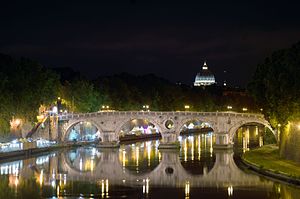Ponte Sisto
Coordinates: 41 ° 53 ′ 32 " N , 12 ° 28 ′ 15" E
| Ponte Sisto | ||
|---|---|---|
| place | Rome ( Italy ) | |
| construction | Arch bridge with vaulted vaults | |
| overall length | 105 m | |
| width | 20 m | |
| completion | 1479 (Roman predecessor buildings) | |
| location | ||
|
|
||
The Ponte Sisto is a stone road bridge in the old town of Rome with a length of 105 m and a width of 20 m. It was built between 1473 and 1479 and crosses the Tiber .
Predecessor bridge
The Ponte Sisto was built to replace a ruined bridge from ancient times a little further upstream, the name of which has not yet been clarified. Depending on the source, it is called Pons Aurelius , Pons Agrippae or Pons Antoninus . The prevailing belief is that it was destroyed during the 792 flood. It may have been badly damaged by the flood in 589.
Ponte Sisto
The bridge was built between 1473 and 1479 according to plans by the architect Baccio Pontelli (in dispute). It connects Via Giulia via Via del Pettinari to the left of the Tiber with Piazza Trilussa in Trastevere . It has four arches. In the middle there is a round passage almost below the balustrade between the second and third arches so that the bridge can pass more water through during high tide. The bridge was made financially possible by an estate of Cardinal Torquemada, which went to the Dominicans of the Church of San Maria sopra Minerva.
It was created at the instigation of Pope Sixtus IV (1471–1484), who feared a large pilgrimage for the Holy Year 1475 and therefore wanted to improve the infrastructure of Rome. He decreed for this year that pilgrims should follow a certain traffic flow in order to avoid a traffic gridlock. The bridges should only be used in a one-way system: The Angel's Bridge should only be used in the direction of St. Peter's Basilica . On the way back, pilgrims should take Via della Lungara to the Tiber and then walk along the bank to use the Ponte Sisto.
Today the bridge is reserved for pedestrians only. The next bridge to the north is the Ponte Giuseppe Mazzini , the next to the south is the Ponte Garibaldi . From the 17th to 19th centuries there was a fountain called Fontana di Ponte Sisto at the bridgehead on the Trastevere side. This is now on the Piazza Trilussa.
Inscriptions
On the left bridgehead there are two inscriptions from the 15th century, penned by Bartolomeo Platina , a librarian at the Vatican Library.
First board
Original in Latin :
- XYSTVS IIII PONT MAX
- AD VTILITATEM P RO PEREGRINAEQVE MVLTI
- TVDINIS AD JVBILAEVM VENTVRAE PONTEM
- HVNC QVEM MERITO RVPTVM VOCABANT A FVN
- DAMENTIS MAGNA CVRA ET IMPENSA RESTI
- TVIT XYSTVMQVE SVO DE NOMINE APPELLARI VOLVIT
German translation:
- Sixtus IV. Pontifex Maximus
- left for the benefit of the Roman people and the pilgrims of the Holy Year
- this bridge, which was rightly called "broken",
- from the ground up carefully and costly to rebuild and
- wish they should give her his name.
Second panel
Original in Latin:
- MCCCCLXXV
- QVI TRANSIS XYST QVARTI BENEFICIO
- DEVM ROGA VT PONTEFICEM OPTIMVM MAXI
- MVM DIV NOBIS SALVET AC SOSPITET BENE
- VALE QVISQVIS ES VBI HAEC PRECATVS
- FVERIS
German translation:
- 1475
- You who by merit
- Sixtus IV crossed this bridge,
- ask the Lord to give us the Pontifex Maximus
- receive long and stand by him.
- Farewell once you have asked whoever you are.
Individual evidence
- ^ Translated freely from Koci Montanari, pp. 54f.
literature
- Silvia Koci Montanari: The ancient bridges of Rome . Schnell & Steiner, Regensburg 2006, ISBN 3-7954-1814-3 .
See also
Web links
- History of the bridge on blog from Rome (German)
- Illustrated article at www.romeartlover.it (English)
- Description in Roma Segreta (Italian)


